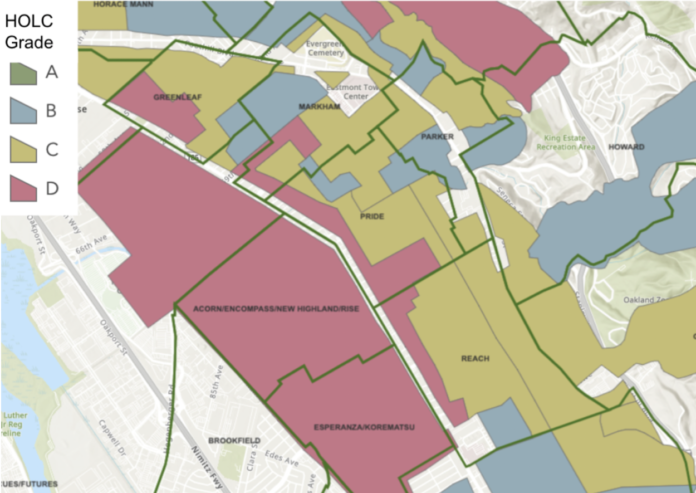As part of the New Deal development in the United States beginning in the 1930s, the Home Owners’ Loan Corporation (HOLC) drew demarcations in metropolitan areas to separate communities by level of predicted loan risk. This neighborhood ranking system lined white-dominated communities in green, effectively communicating to banks that they were a ‘safe’ place to provide home loans to. Majority Black neighborhoods were ‘redlined.’ Houses in green zones appreciated and those in red zones were left to plummet in value. Today, the legacy of redlining not only represents income inequality by race, but also the segregation of American public schools.
Some Oakland secondary schools, like McClymonds High School, have a white student population of 3.9%. Meanwhile, Oakland Tech’s percentage of white students is 24.6%, as of 2019. These disparities are the direct result of the HOLC’s redlining that took place almost a century ago. The included image marks school districts in green lines and the HOLC neighborhood ranking systems in blocked color. Great School Voices reports that a minimum of 10 Oakland school boundaries overlap with at least 75% of a redlining area.
But it is not solely online platforms that are monitoring the racial disparities in Oakland schooling. Ray’Von Jones, head of the Race, Policy, and Law (RPL) academy at Oakland Tech and an RPL educator, says that “teaching at Oakland Tech has exposed [her] to how much privilege persists even within OUSD.” When asked what percentage of students in the Oakland Unified School District are white, her students offer up answers between 30-60%. In reality, that number is closer to 11%. So why does whiteness seem to encompass so much of the city’s school district? Jones argues that “while Brown v. Board integrated some schools, this also led to the erosion of the Black teaching force and forced Black students into institutions that were committed to white supremacy.”
Schools in low-income and majority-POC communities tend to lack Parent-Teacher Associations (PTAs), a major source of funding for each institution. Without these groups to fundraise, schools must rely solely on money allotted to them by the US Department of Education. These federal resources do not account for electives, like Art and Music, leaving low-income schools without access to those creative outlets.
For these reasons, it becomes clear that school district rezoning is key to combating redlining and addressing inequity within OUSD schools. Kayla Millheim, a senior at Oakland Tech, has spent the past five months researching the process of rezoning, and proposes that drawing intentionally desegregating school zone boundaries would mitigate the effects of redlining on public school education. Millheim discusses the importance of a committee organized by the school board to oversee the process and set a precedent to redraw in the future. Further, she emphasizes the importance of youth voices in these efforts. Public school students experience the detriments of this system daily and are therefore the key to solving it.
